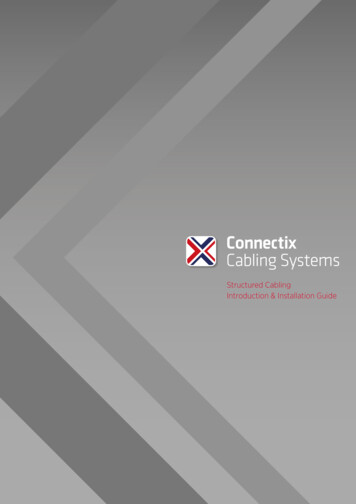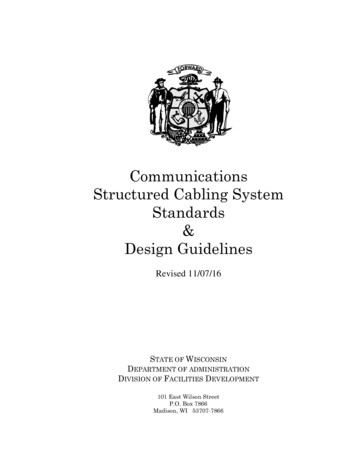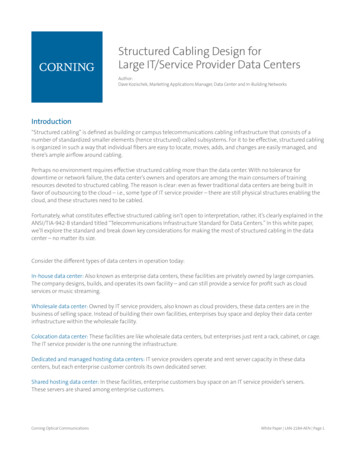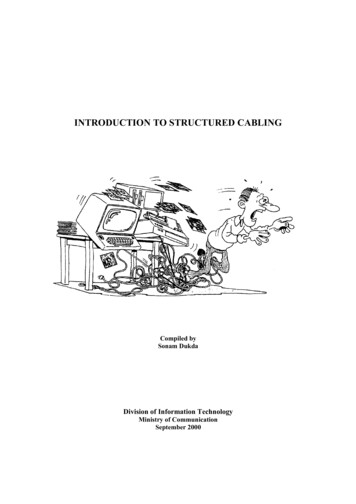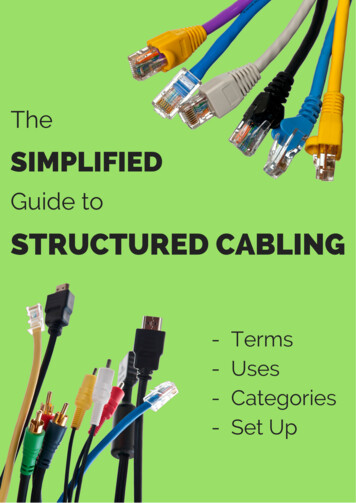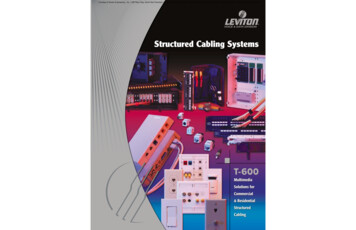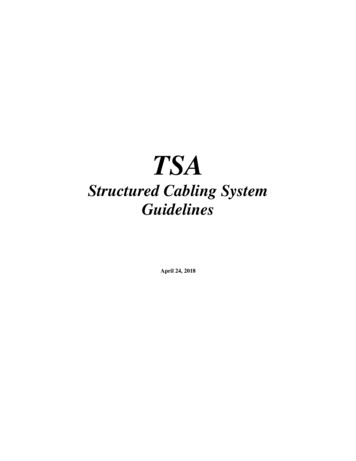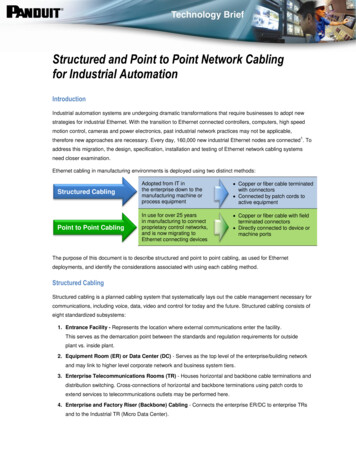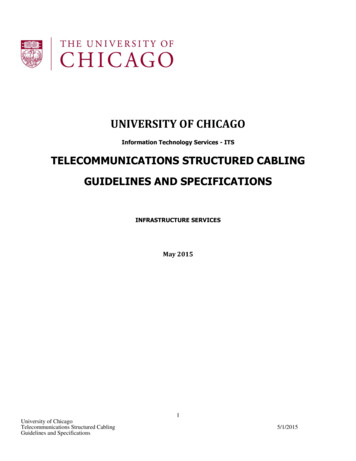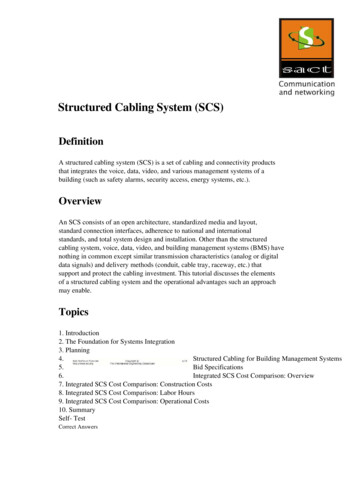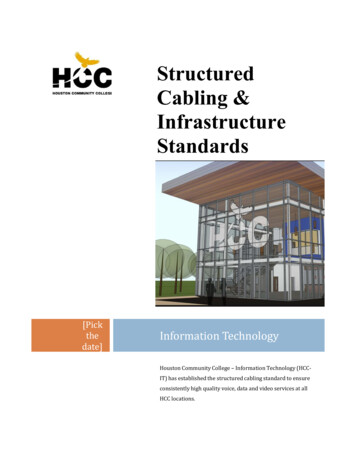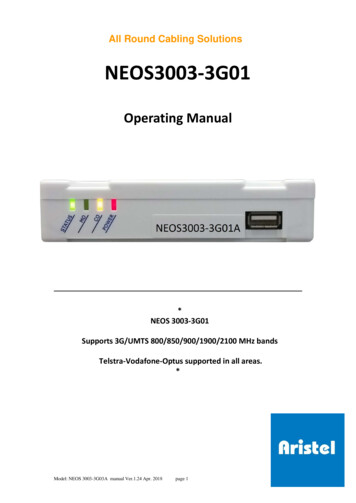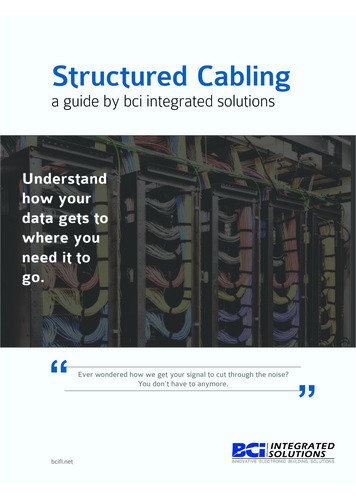
Transcription
Structured Cablinga guide by bci integrated solutionsUnderstandhow yourdata gets towhere youneed it togo.Ever wondered how we get your signal to cut through the noise?You don’t have to anymore.bcifl.net
OverviewCabling is kingStructured cabling and data networks have comea long way from the electromagnet and telegraph of the 19th century. A series of inventionsincluding the telephone, radio, television, and computer have built upon the foundations of electricitydiscovered by some of the greatest minds in humanhistory.Today, we have a profound understanding of whatit takes to achieve the clarity and reliability youdemand from your communications technologyat home and in the workplace. As more markets findways to leverage a strong network into opportunitiesfor business growth, getting the right information towhere it needs to be is more important than ever.2Data & Structured CablingCreating networks with cabling has a long historystretching back to the invention of the telephone.Have you ever wondered how we made it towhere we are today?03You’ve probably heard of Cat6, Cat6a, fiber optic,and many other integral components to structuredcabling. But do you know what the difference isbetween them, and which your business needs?05Data transmission and structured cabling changesfrequently with the technology it has to serve.Learn about some of the newest players on themarket.07Want to learn more? Check out our contact infoand schedule a walkthrough, lunch and learn, orjust give us a call.09
HistoryData is a precious thing and will last longer than the systems themselves.Tim Berners-Lee, inventor of the World Wide WebCables of two centuries ago were (and usuallystill are, unless you have special requirements)unshielded, insulated wire made from readilyavailable materials like copper. One of the first commercial applications of copper wiring was the telegraph. Thetelegraph made use of technology like the electrical relayand electromagnet preceding it.Telegrams for communication stayed prominent intothe 20th century to connect the world via underwater cables. Over time, telephones gained ground formore local connections, and by the 21st century usurpedtelegraph technology entirely. But the vehicle for bothtechnologies remained the same, and copper is still anexceptionally popular choice for cabling.Recently, the introduction of new technologies likestreaming and Voice over IP (VoIP) have requiredcabling solutions to marshal more and more capacity for change. Instead of copper, some signals are senttoday using optical fiber. Optical fiber is more expensiveto install, and requires a greater understanding than copper wiring, but it can pay for itself by creating opportunities to cut other costs, ensure better connections, andfuture-proof your structured cabling system.Accommodating new convergent technologies isan everyday challenge for system integrators andnetwork cabling companies. Whether you have ananalog system or a top-of-the-line optical fiber network,it’s important to understand the science behind the tech.BCI Integrated Solutions3
Wait. how does all this work?CSOabling sends data packets across its length by cycling electricity in a series of 0s and 1s to produce a responseor transmit a signal. The number of times the cable can switch between 0 and 1 is generally measured in Megahertz, equal to one million hertz. But the most powerful network cabling today can handle thousands of Gigahertz per second, and those numbers are only growing.tandard twisted pair cables are typical network connectors, widely available today for your own Ethernet connection or network. Your home may connect to the grid with optical fiber or copper wiring depending on your internet service provider’s offerings and their last-mile policy. Optical fiber, unlike copper twisted pair cables, is largelyfuture-proof because the optical fiber infrastructure can last indefinitely. It only needs to have its electronics upgraded.ptical fiber produces infrared wavelengths anywhere from 650 to around 1600 nanometers, depending onthe grade. Copper wiring produces microwaves, which have a lower wavelength and frequency than infraredwaves. This means they cycle less quickly than fiber, resulting in less data sent. Optical fiber is quickly becoming the preferred cabling method for its comparatively faster speeds and longer lifespan, but it’s still more costly thancopper wiring. Both kinds of cabling have a lot of life to them and will be common for years to come.4Data & Structured Cabling
Now that you know a little bit about the history of structured cabling and datanetworks and how they work, let’s take a closer look at some of the technologythat makes today’s systems so powerful.Modern cabling typesiCategory 6, or Cat 6, is a popular cabling standard offering performanceup to 250 MHz at a distance of 55 meters or 180 feet. A successful Cat6 installation may need to make use of shielding, and must groundon both ends, which can contribute to interference. Cat 6 are typical patchor crossover cords connecting different devices to the same network. Cat 6cabling is widely available and relatively inexpensive, serving as the baselinefor adequate system performance today.iCategory 6A doubles the capacity of Cat 6, offering 500 MHz at 100meters distance, or around 328 feet. The improved cabling offersgreater performance than its predecessor, and is also widely available,but more expensive.Cat 6A is a strong technology used for access control, building automation,audiovisual systems, and more, and favored for many new installations.iOptical fiber differs from Category cables because of how quickly itcan send data. Instead of transmitting through electrical impulses, itsends pulses of light modulated to carry information. Optical fiber canhandle cycles anywhere from 500 MHz to 4700 MHz, equivalent to anywhere from 10 MBit/s to 10 Gbit/s of data over up to 600 meters or 2000feet.Optical fiber allows data to travel significantly faster than Ethernet cables,though not as fast as the speed of light itself. It’s the preferred form of cabling across long distance, or if your connection needs a lot of power.BCI Integrated Solutions5
Other common data network termsVoice over Internet Protocol, or VoIP, offers a phone connection over the internet. Thisallows more direct multimedia delivery than having to send packets of data because itallows two users to dial into the same domain to communicate instead of establishinga direct telephonic connection. By eliminating the need to route traffic, VoIP provides betterease of access and coordination. iMessage, one of Apple’s most popular features, is a VoIPservice offering near-instantaneous syncing to iPhones, iPads, and Macs. The connection canbe bidirectional and maintained, adding cool features like read receipts and enhanced sharing.Single-mode and multi-mode are different kinds of optical fiber. Depending on your signalstrength and distance needs, you may want to use one type over another. Optical fiber ismeasured using categories OM1, OM2, OM3, OM4, OM5, OS1, and OS2. Different categories denote different wavelengths, different cable width, and sometimes different emissionmethod. Some optical fibers use LED, some use VCSEL, and others use EEL. You may prefer aspecific style depending on your distance or strength needs.Twisted pair cabling, invented by Alexander Graham Bell, reduces external electromagneticinterference and radiation and cuts down on “crosstalk” between pairs or different cables.Because there is less of a gap between twisted pairs than straight pairs, interference hasa much tougher time passing through the pair.Cabling comes shielded or unshielded, referred to as STP or UTP respectively. Shieldingbuilds on the twisted pair model by creating a barrier between electromagnetic interference and the copper cabling. Depending on the system you’re trying to set up, you mayopt for little to no shielding, or you may need significant shielding to prevent electromagneticinterference (EMI). UTP cables are frequently used in the home, for security cameras, and atshort and medium length. In areas of high EMI or data transmission needs, STP may be a better option.Who sets the standards for building datanetworks and structured cabling?BICSI, the Business Industry Consulting ServiceInternational, works with the TelecommunicationsIndustry Association, the International Organization for Standardization, and other authorities to ensurecabling compatibility across the globe. BICSI approvesstructured cabling specifications related to design, wavelength, capacity, shielding, and many other variables.6Data & Structured CablingCredentials are also managed by BICSI. Certifiedprofessionals get one of four titles offered by theorganization: Registered Communications Distribution Designer (RCDD), Data Center Design Consultant(DCDC), Outside Plant Designer (OSP), or RegisteredTelecommunications Program Manager (RTPM).BICSI and its affiliates are responsible for improvingthe technology you use every day, and the knowledge of the designers and technicians who bringthose systems to life.
What do we try to improve about cabling?The technology behind data/network cabling and communications grows with user needs.Stronger cabling offers a greater capacity to handle “change,” or cycles between 0 and 1.The binary combinations translate into system actions on the user end. Better cabling orfiber gets those combinations where they need to go, stronger and faster.You’ve already learned thatcopper cabling and opticalfiber transmit data throughdifferent wavelengths, and vary theirfrequency and amplitude dependingon the cabling used. But what is itthose cables are sending? Depending on how the signal is modulated,the 1s and 0s mentioned above“combine” into instructions for thecomputer to display, and for us tounderstand. For instance, the word“love” is 01101100 01101111 0111011001100101. This plays out hundreds ofthousands of times per second untilthe computer successfully displaysthe text, image, or other data expected.Another thing we try to improve about cabling is its protection from the environment.Wiring an office or hospital is muchdifferent than a stadium or outdoorrestaurant. Moisture, heat, light, wind,and other variables affect how longcabling can last. Better protectiontechnology means stronger cable.BCI Integrated Solutions7
New faces in structured cablingi iCategory 8, or Cat 8 cabling, features speedsof up to 2000 MHz, terminating at maximum distances of about 120 feet. Cat 8 butfocuses on accommodating shorter distances inplaces like data centers. So, if you work in an office,your data center may upgrade to Cat 8 cabling, butyou won’t be getting a Cat 8 ethernet connection.Cat 8 cable comes shielded and requiresproper grounding and installation. Its useas a patch for high-speed connection fromserver to server and rack to rack means placingextra emphasis on a successful installation. Cat 8offers an affordable alternative to optical fiber forthe many systems that still rely on quality coppercabling.Distributed Antennae Systems (DAS), alsocommonly referred to as cell signal boosters,amplify primarily cellular signals in areas thatwould otherwise not receive them. Signals are sentfrom cell sites and repeater stations to bring coverage to your phone, but some modern circumstances make that more difficult. Buildings made from“thick” material like concrete or built many storieshigh get reduced signal because of interference.DAS can be either “active” or “passive” dependingon your needs. Active systems pass signal fromantennas (usually on the roof) through fiber cables,while passive systems “leak” signal throughout abuilding.Agreat example is the recent upgrades tothe New York City Subway, which recentlyinstalled DAS in many of their subway stations to bring cellular signal underground. DAS arevery popular in high rises, hotels, hospitals, concretebuildings, and other areas with high interference.Cat 8 cables, cell boosters, and other technology boosting signal in hard to reach places orthe speed of data transmission will see increasing demand as cellphones and internet access become even more ubiquitous and necessary to conduct business.8Data & Structured Cabling
What to expect from the futureThere are all kinds of improvements being made to communications and data networkinginfrastructure. As we gain a better understanding of how to manipulate the modulation oflight and electricity into data, we improve the speed, quality, and availability of that data.Data and network cabling is aconstantly growing field, and inall likelihood there will one daybe a Category 9, new standards foroptical fiber, thinner cables transmitting data more effectively, and manymore innovations. Remember, we’reafter more Megahertz, longer transmission lengths, and less electromagnetic interference.Convergence also offers a seriesof opportunities like the expansion of IPTV, or deliveringTV over the internet instead of withcabling from your television serviceprovider. Improvements to other techlike digital broadcasting, geolocationservices, and much more are on thehorizon.One of the most soughtafter improvements to datatransmission and networkingis wireless data transfers. What if, instead of using optical fiber or copper,you could send data directly throughthe air instead? You’ve probably seensome of the limitations in action.Hooking an ethernet cord up to yourmodem or router results in a fasterconnection than a wireless signal cansend.The gap between the two decreases as we make improvements to the technology behindit, but it’s unlikely it’s eliminatedentirely. Optical fiber is the closestwe can get to transmitting data atthe speed of light, because it literallyis the concentrated transmission oflight without a vacuum. Changingthat would require a meteoric shift inscientific understanding.But stranger things have happened. The future promisessweeping improvements inevery mode of information transportation.BCI Integrated Solutions9
Would you like to join us for lunch?We’d love to talk to you about your next big structured cabling project over an officemeeting, lunch-and-learn, or visit to your site for analysis. We also offer a variety of othersolutions including audiovisual, security, and communications systems, plus fire alarm andlife safety technology. Contact us to schedule a meeting and take a big step forward.Thank you!We hope you learned everything you want to know about data and network cabling, a fascinating and integral component of low voltage systems. Without great cabling, you can’thave great data transmission, and without great data transmission, your network couldsuffer.9419 Corporate Lake Drive, Tampa, FL 33624Telephone: (813) 249-1020 or toll-free at (877) 616-2538Web: bcifl.netEmail: marketing@bcifl.net10Data & Structured Cabling
New faces in structured cabling C ategory 8, or Cat 8 cabling, features speeds of up to 2000 MHz, terminating at maxi-mum distances of about 120 feet. Cat 8 but focuses on accommodating shorter distances i
